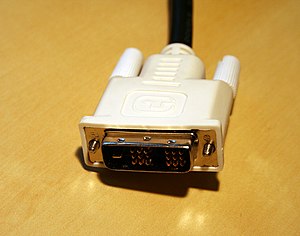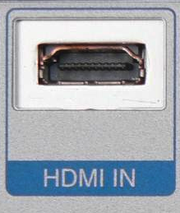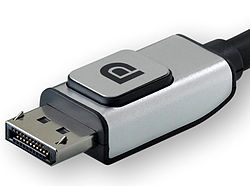To connect a TV or monitor to a cable box, DVR, or computer you can use Analog connectors (component or VGA for HD, SVideo or composite for SD) or Digital connectors (DVI, HDMI, Displayport).
In an old CRT TV set or computer monitor, the incoming signal was a wave of continuously varying voltage. In a color TV or monitor, the signal was filtered and broken into three separate voltage differences that were amplified and fed to three electrodes at the back of the picture tube. These electrodes generated varying numbers of electrons that swept across the screen driving red, green, and blue dots of phosphorescent material that produced the colored light in each dot
Imagine really, really fast bartender who lines up three rows of shot glasses across the bar. Then he runs once down the length of the bar continuously pouring a stream of three colored liquors varying the amount of the pour of each color as he passes over one group of three glasses. No matter how good you are, you can only approximately control the amount of liquid in each glass given splashing and the inaccuracy as you move across the edge between glasses. This is an analog system, and the pouring of liquid into a shot glass is basically the same as the CRT shooting a stream of electrons into each dot on the monitor screen.
In contrast, a modern flat panel monitor or HD TV receives a number (typically a byte with a value between 0 and 255) for each dot on the screen. The number represents the degree of brightness or the amount of light to generate at that dot. It is then up to the electronics of the screen to match the indicated brightness.
A digital connection is more precise and generates a sharper picture with more accurate colors. An HD connection supports the higher screen resolutions. However, exactly which connector is best in practice depends on all the hardware.
RF
The cable that comes in through the wall, whether from a rooftop antenna or cable system, is the RF signal (Radio Frequency). It is also an “RG6” cable with a screw on “F” type connector.

Twenty five years ago, TV sets didn’t have any other inputs, so the cable TV box would connect to the VCR and the VCR would connect to the TV with additional short RF cables.
A cable TV system typically has 135 separate TV channel frequencies (more on newer systems). The first 60 or so will typically be old analog SD channels that carry a signal that can be directly received by your twenty year old TV set in your basement. The higher numbered channels are typically digital because the cable company can squeeze 10 digital SD TV programs in the same channel frequency used to carry one old analog program.
The RF cable that comes from the wall can be split into several connections, but the more times it is split the weaker the signal gets. If you need to split the signal into more than three or four connections, you may need the kind of splitter the cable companies use that has a built in amplifier. Be careful, however, because if you over amplify the TV signal the result is worse than a weak signal. Signal strength is measured in DB, and the conservative choice is to get a device that generates the same DB out as it gets in.
The RF signal can be plugged into a cable TV set top box, TV, or some type of recording equipment (Tivo, VCR, or a device connected to your computer). Analog recording equipment will record the analog channels, while newer digital TV recorders can directly record the free (over the air or unencrypted “clear QAM” cable) digital TV channels, and premium channels if the device has a slot for a CableCard.
The reason for RF is to support hundreds of frequencies and program streams on one cable. Once you plug into the first device, whether a cable set-top box or DVR, and that device selects a particular program stream to decrypt or record, then RF is the worst choice to use in subsequent connections between different devices.
Analog Box-to-Box Connectors
There are four types of analog cables listed by reduced picture quality:
Component

Component (Y Pr Pb) cable has three connectors. They carry a Black and White signal (“Y”) on a green RCA connector, and two separate color signals on red and blue RCA connectors. This is the only type of analog connector that carries an HDTV signal. It is still supported by TVs, set-top boxes, and DVRs, although a digital connector is typically better. However, content owners (movie studios) require that premium content (HBO, Showtime) be encrypted when it is transmitted over a digital connection, but they allow HD analog video up to 1080i. So Component cables may still be a good choice if you have to get an unencrypted signal.
Component cables are a TV standard. Although the cables are colored Red, Green, and Blue, the signals are not RGB. The signals are Black and White, and then two color differentials.
VGA

VGA is a 1987 computer monitor standard that is still in wide use. It has three rows of 15 pins in a D-shaped shell. The pins carry signals for Red, Green, and Blue colors.
VGA is a computer, not a TV standard. It does not have a Black and White signal. Modern flat panel TV sets and projectors have a VGA connector, but mostly for connection to a laptop computer. Some TV sets do not expect to get TV resolutions (720p and 1080i) over the VGA connector, and it is not necessarily a connector you will find on the back of a set-top box or DVR.
SVideo

SVideo (Y/C) is a round connector with four pins. It carries an SD TV program on two pairs of wires, one for the Black and White (“Y”) signal and a combined color (“C”) signal. Because the two color signals have been combined on a single wire, they have to be split out again on the receiving device. SVideo was the best option available twenty years ago but because it does not support HD it is not a good choice today.
Composite

Composite is a single RCA connector that combines all three signals (Black and White and two color signals) on one wire. The receiving device has to first split the black and white Y signal from the C color signal, and then has to split the C signal into its two components. This has the lowest quality for SD and cannot support HD. In most cases, if you are using composite today you are making a mistake.
Digital Connectors
Digital is better. Since digital is a stream of numbers transmitted without error, different types of digital cable carry the same quality of signal and differ in the size and type of connector. All cables can handle 1080p, the highest TV resolution.
DVI

A DVI connector is found on most flat panel computer monitors and computer video adapters. The plug pictured here is a “single link” because there is a gap between the two blocks of pins. It supports the resolution of all reasonably priced monitors.

If you look at the general diagram of DVI you see two additional features. When the middle block of nine pins is present, this is a “dual link” DVI that can support one of those Dell or Apple 30 inch computer monitors with 8 million dots on the screen. Around the flat bar or cross on the right are some analog pins labelled C1 to C4 that provide Red, Green, and Blue signals. Most video adapter cards with DVI connectors provide a plug that converts these four analog pins (and some ground wires) into the VGA plug described above. Thus DVI is big, but it provides a transition supporting both high resolution digital video and old analog VGA where needed.
Some connections are DVI-D and do not have the analog pins. Before you assume that you can convert DVI to VGA, look to make sure the analog pins are there.
These days, most DVI cables support HDCP signal encryption and can, therefore, play Blue-Ray movies at their best resolution.
HDMI

HDMI started as a TV standard. It has a smaller connector than DVI.
HDMI has a digital signal that can be converted to a DVI-D connection with an adapter plug or cable. So the digital signal part is the same as DVI. However, since this was originally a TV standard and TV resolution maxes out at 1920x1080, most HDMI cables and connections cannot run 30” computer monitors with super high resolution. The very latest HDMI standard improves this, but you need to check to make sure all your equipment and cables match that standard if you need maximum resolution.
HDMI does not have the analog pins, so it can never be converted to VGA.
HDMI does, however, have a digital audio connection. When connected to a TV set, you can send both picture and sound through the cable. With DVI you have to make a separate audio connection with analog or digital audio cables.
Digital connections transmit data exactly, so the movie companies became scared that someone would use them to make exact copies of movies. So licensed Blu-Ray movie players will only transmit data on one of these three digital connections if it is scrambled by the HDCP encryption technology. The Sony PS3 is a Blu-Ray player, so it requires HDCP before it will talk to a monitor over an HDMI cable.
DisplayPort

DisplayPort is a new standard with a cable the size of HDMI but the bandwidth of dual link DVI. It will be the wave of the future, but it is often not available on a video card or mainboard.